Skype: neodalle-travel
Tel: +86 135 7447 2266
E-mail: sales@visitaroundchina.com
The design of Qianling replicates the city of Chang'an and in accordance with tradition is on a north-south axis. The southern approach is set between two smaller hills and the way to the Emperor's tomb is lined with stone animals as well as human figures. These include horses and ostriches, winged horses and a pair of stone lions. In all there are 124 stone sculptures and these are reminders of the fact that the Tang was very much involved with trade and diplomatic exchange with the world far beyond China's borders as there are distinct Western Asian and Greek influences in these sculptures.
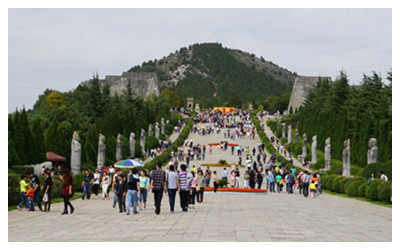
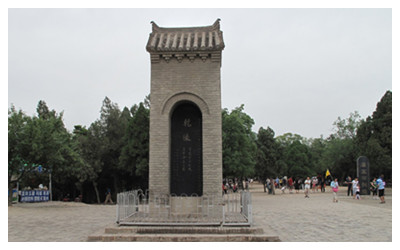
In total the site covers an area of 2.3 square kilometers and within this area stood 378 buildings that included the Sacrifice Hall, a Pavilion, a Hall of Ministers and numerous corridors. Unfortunately, the above ground structures have not survived unlike the stone sculptures that still delight visitors. Two ornamented octagonal columns mark the south entrance and the mythical winged horses are the first of the sculptures.
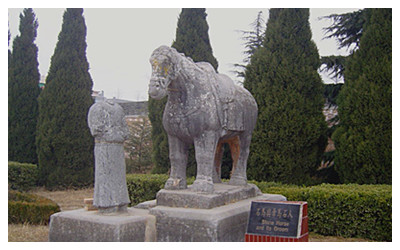
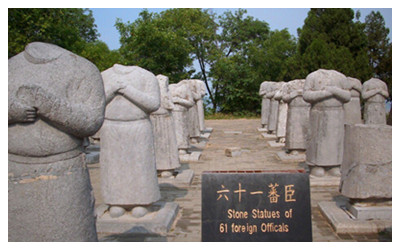
The pair of ostriches was a gift from Afghanistan; of the five pairs of horses that are next along the route only three still have their attendant grooms. Ten pairs of military figures bearing swords stand guard along the path. Further life-sized sculptures of men represent the sixty one foreign emissaries that attended the Emperor's funeral and were created on the instructions of Empress Wu Zetian, who wanted a permanent reminder of their visit. Each figure is depicted in a long robe with a wide belt and wearing boots. The name of each individual and the country he represented is carved on the back of the statue. It is not known how or why but regrettably each statue has been decapitated at some time in the distant past.
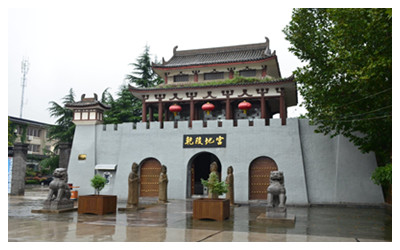
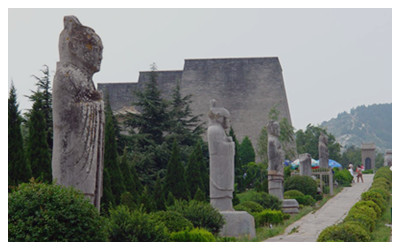
The Qijie Bei (Tablet of Seven Elements), so called because it symbolizes the Sun, Moon, Metal, Wood, Water, Earth and Fire, carries an inscription composed by the Empress Wu Zetian that describes the achievements of her late husband. The calligraphy is that of Emperor Zhongzong whom the Empress deposed but later returned to the throne following her own eventual retirement from office.
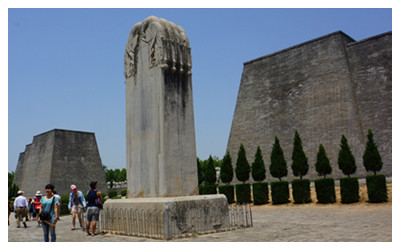
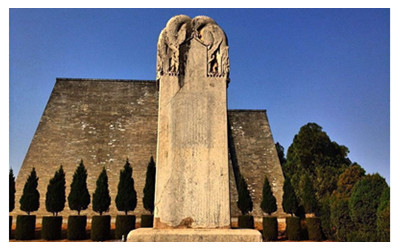
An unusual feature is the Blank Tablet that has carved dragons and oysters upon it but no inscription, there is nothing like this at any other royal tomb site. It is thought that this tablet was erected upon the orders of the Empress and that it would eventually bear a description of her achievements, to be recorded by some future generation. Maybe she thought that in this way only her good deeds would be remembered and recorded for posterity!
Travel Tips
How to get there:
1. Take a train from Xian Railway Station to Qianxian, and then take local Bus 1 to Qianling.
2. Take a long distance bus from Xian West Bus Station to Qian County. After arrival, local bus 2 will take you to Qianling Mausoleum.
Entrance Fee:
Mar. - Nov.: CNY 122; Dec. - Feb.: CNY 82
The ticket fare includes the mausoleum, the Tomb of Crown Prince Zhanghuai, the Tomb of Prince Yide, and the Tomb of Princess Yongtai (Qianling Museum).
Opening Hours: 08:00-17:30
 Ask Questions ?
Ask Questions ?